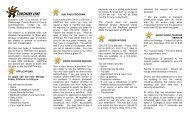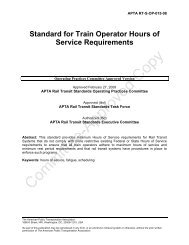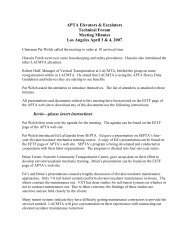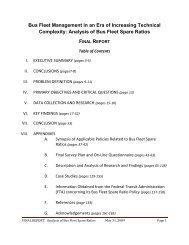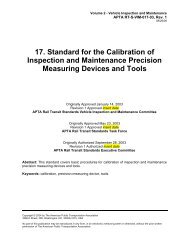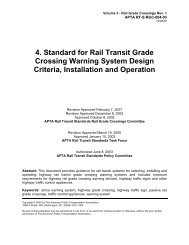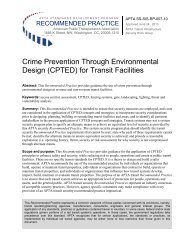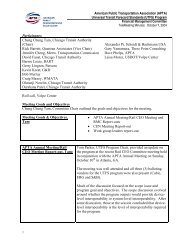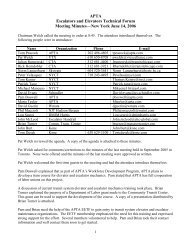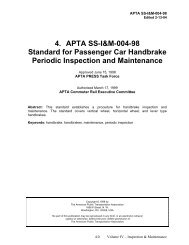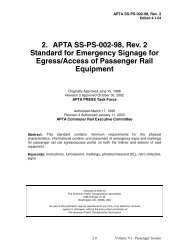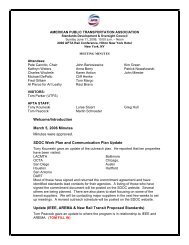Standard Bus Procurement Guidelines - APTAStandards.com
Standard Bus Procurement Guidelines - APTAStandards.com
Standard Bus Procurement Guidelines - APTAStandards.com
You also want an ePaper? Increase the reach of your titles
YUMPU automatically turns print PDFs into web optimized ePapers that Google loves.
<strong>Standard</strong> <strong>Bus</strong> <strong>Procurement</strong> <strong>Guidelines</strong><br />
equipped with replaceable bushings or inserts and lubrication fittings easily accessible from a pit or<br />
hoist.<br />
5.3.2.2 STRENGTH<br />
Fatigue life of all steering <strong>com</strong>ponents shall exceed 1,000,000 miles. No element of the steering system<br />
shall sustain a Class I failure when one of the tires hits a curb or strikes a severe road hazard.<br />
5.3.2.3 TURNING RADIUS<br />
Outside body corner turning radius for a standard configuration 40-foot long bus shall not exceed 44<br />
feet.<br />
5.3.2.4 TURNING EFFORT<br />
The steering wheel shall be no less than 19 inches in diameter and shall be shaped for firm grip with<br />
<strong>com</strong>fort for long periods of time. The steering wheel shall be removable with a standard or universal<br />
puller.<br />
Hydraulically assisted power steering shall be provided. The steering gear shall be an integral type with<br />
flexible lines eliminated or the number and length minimized. Steering torque applied by the driver shall<br />
not exceed 10 foot-pounds with the front wheels straight ahead to turned 10 degrees. Steering torque<br />
may increase to 70- foot-pounds when the wheels are approaching the steering stops. Steering effort<br />
shall be measured with the bus at GVWR, stopped with the brakes released and the engine at normal<br />
idling speed on clean, dry, level, <strong>com</strong>mercial asphalt pavement and the tires inflated to re<strong>com</strong>mended<br />
pressure. Power steering failure shall not result in loss of steering control. With the bus in operation the<br />
steering effort shall not exceed 55 pounds at the steering wheel rim and perceived free play in the<br />
steering system shall not materially increase as a result of power assist failure. Gearing shall require no<br />
more than seven turns of the steering wheel lock-to-lock.<br />
Caster angle shall be selected to provide a tendency for the return of the front wheels to the straight<br />
position with minimal assistance from the driver.<br />
5.3.3 BRAKES<br />
5.3.3.1 SERVICE BRAKE<br />
5.3.3.1.1 ACTUATION<br />
Service brakes shall be controlled and actuated by a <strong>com</strong>pressed air system. Force to activate the brake<br />
pedal control shall be an essentially linear function of the bus deceleration rate and shall not exceed 50<br />
pounds at a point 7 inches above the heel point of the pedal to achieve maximum braking. The heel<br />
point is the location of the driver’s heel when foot is rested flat on the pedal and the heel is touching the<br />
floor or heel pad of the pedal. Microprocessor controlled ABS and traction control shall be provided.<br />
The total braking effort shall be distributed between all wheels in such a ratio as to ensure equal friction<br />
material wear rate at all wheel locations.<br />
Technical Specifications 144 10/18/07



